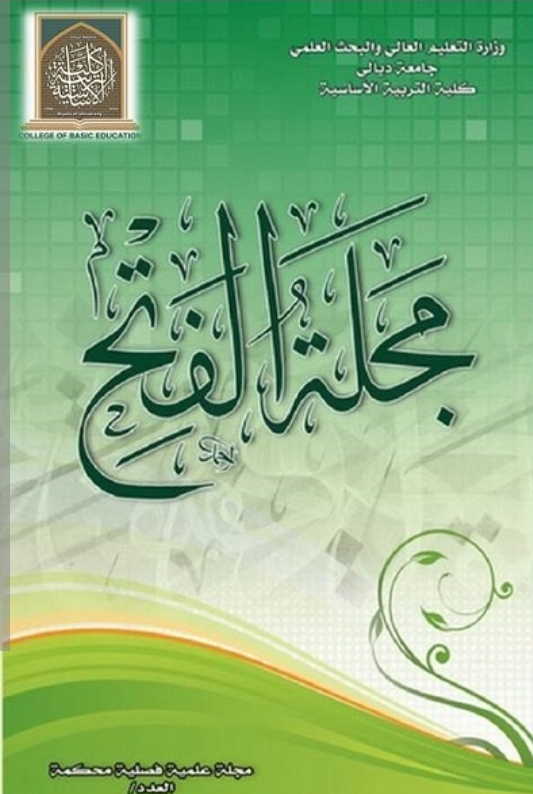The Impact of Using Buxton Model on the Achievement of Fourth Graders (Scientific Branch) Students in Mathematics
Keywords:
Buxton model, collectionAbstract
The aim of this paper is to find out the impact of using Buxton model on the achievement of fourth graders (scientific branch) in mathematics. So as to achieve the aim of the paper, one hypothesis was developed (there is no statistically significant difference at the level (0.05) between the average scores of students in the test group who are studying mathematics according to the Buxton model and the average scores of the students in the control group who study in the traditional method in the achievement test in mathematics). Moreover, to verify the validity of this hypothesis, the researcher conducted her experiment where the research was limited to fourth grade students (scientific branch) with the adoption of the experimental design of partial adjustment of two groups (test and control) with post-testing. Furthermore, the researcher has intentionally selected (Al-Had Al-Akhdhar High School) for the application of the experiment. Then, she has randomly selected Section A to represent the test group, while Section (B) represented the control group. Additionally, the research sample comprised (56) students; (28) students in the test group, and (28) students in the control group.
Next to that, the researcher has statistically matched students of the two research groups using the two samples T-test in the following variables (IQ test, previous achievement in mathematics, previous knowledge).
After identifying the topics of the scientific material to be taught during the duration of the experiment, the researcher formulated behavioral objectives, prepared teaching plans, presented them to a group of experts and specialists to judge their validity, and made necessary adjustments to make the plans ready to be implemented in the light of their views.
References
-أحمد ،علي عبد الحميد(2010): التحصيل الدراسي وعلاقته بالقيم الإسلامية ،مكتبة حسن العصرية للطباعة والنشر والتوزيع ،بيروت ،لبنان
- جبر،ايات محمد (2014):أثر استخدام انموذج بكستون في تحصيل طالبات الصف الثاني المتوسط في مادة الرياضيات ،جامعة ميسان،كلية التربية.
-الجلالي لمعان مصطفى (2011): التحصيل الدراسي، ط1، دار المسيرة للنشر والتوزيع، عمان .
-حسن ،وردة يحيى ومهند فاضل عباس (2017):اثر استخدام انموذج بكستون في اكتساب المفاهيم الرياضية لدى طلاب الصف الثاني المتوسط في مادة الرياضيات،المديرية العامة لتربية محافظة ديالى
-الدليــمــي، هنــــــاء رجــــــب، عبــــد الله العبيـــــــــدي، (2004): "دلالات الصـــــدق والثبات لاختبار دانليز" فـي مجلة حولية وحدة أبحاث الذكاء، العدد، الجامعـــــة المستنصريــــــة، كليــة التربيـة الأساسية، بغداد
-الزبيدي احمد محمد عبد (2010): أثر الأسئلة السابرة في اكتساب المفاهيم الهندسية لدى طلاب الصف الأول المتوسط في مادة الرياضيات ، جامعة بغداد ،كلية التربية ابن الهيثم.
- الساعدي، فرات غني نوري (2011): أثر ااستخدام نموذج بكسـتون فـي اكتسـاب المفاهيم الرياضـية والاتجـاه نحو مادة الرياضيات لـدى طالبات الثاني متوسط، رسالة ماجستير غير منشورة، كلية التربية، جامعة بغداد.
-الشارف،احمد العريفي(1996):المدخل لتدريس الرياضيات،ط1،الجامعة المفتوحة-طرابلس،ليبيا.
-عبيدات , ذوقان و سهيلة أبو السميد (2007): "ااستراتيجيات التدريس في القرن الحادي والعشرين" ,دليل المعلم والمشرف التربوي، ط 1 ، دار الفكر.
- قطامي ونايفة قطامي (1998):نماذج التدريس الصفي ،ط2،دار الشروق للنشر والتوزيع،عمان.
-مناع نـور الـدين وعبدالمجيـد الناصـر(2017): أتجاهـات التلاميـذ نحـو مـادة الرياضـيات دراسـة تجريبيـة ميدانيـة لتلاميـذ الجـذعين المشـتركين آدب وعلـوم، مجلـة العلـوم الانسانية والاجتماعية، جامعة قاصدي مرباح، الجزائر.
-هندام، يحيى حامد (1982): تدريس الرياضيات، ط1، دار النهضة العربية، القاهرة، مصر.
المصادر الأجنبية
Buxton, L. (1978). Four levels of understanding". Mathematics in School, vol. 7, No,4, Sep, U.K.
Downloads
Published
How to Cite
Issue
Section
License
Copyright (c) 2024 https://creativecommons.org/licenses/by/4.0/

This work is licensed under a Creative Commons Attribution 4.0 International License.
حقوق النشر والترخيص
تطبق مجلة الفتح للبحوث التربوية والنفسية ترخيص CC BY (ترخيص Creative Commons Attribution 4.0 International). يسمح هذا الترخيص للمؤلفين بالاحتفاظ بملكية حقوق الطبع والنشر لأوراقهم. لكن هذا الترخيص يسمح لأي مستخدم بتنزيل المقالة وطباعتها واستخراجها وإعادة استخدامها وأرشفتها وتوزيعها ، طالما تم منح الائتمان المناسب للمؤلفين ومصدر العمل. يضمن الترخيص أن المقالة ستكون متاحة على نطاق واسع بقدر الإمكان وأن المقالة يمكن تضمينها في أي أرشيف علمي.
لمزيد من المعلومات، يرجى متابعة الرابط: https://creativecommons.org/licenses/by/4.0/.


